
The American financial sector has been rocked by yet another seismic collapse as First Republic Bank becomes the fourth major US banking institution to fail in just two months. The dramatic downfall marks the second-largest bank failure in American history, sending shockwaves through global markets.
In a move orchestrated by federal regulators, banking giant JPMorgan Chase has stepped in to acquire the bulk of First Republic's assets after the California-based lender succumbed to massive deposit flight and crippling losses. The deal, announced in the early hours of Monday morning, saw US regulators seize control of the struggling bank before swiftly orchestrating its sale.
The Domino Effect Continues
This latest collapse follows the dramatic failures of Silicon Valley Bank and Signature Bank in March, along with the earlier closure of Silvergate Bank. The rapid succession of institutional failures has exposed significant vulnerabilities within the American banking system, raising urgent questions about regulatory oversight and financial stability.
First Republic's distinctive business model, which focused heavily on wealthy clients and offered ultra-low interest rate mortgages, ultimately proved to be its undoing. As the Federal Reserve aggressively raised interest rates to combat inflation, the bank found itself trapped with low-yielding assets while facing higher funding costs.
Emergency Measures and Market Reaction
The Federal Deposit Insurance Corporation (FDIC) confirmed that JPMorgan will assume "all deposits, including all uninsured deposits, and substantially all assets" of First Republic Bank. The intervention is expected to cost the FDIC's insurance fund approximately $13 billion, highlighting the scale of the crisis.
Market analysts have expressed concern about the broader implications. "We're witnessing a crisis of confidence in regional banking that shows no signs of abating," noted financial strategist Michael Harris. "The question now is whether this containment strategy will be sufficient to prevent further contagion."
What This Means for the Future
The repeated federal interventions have sparked debate about the adequacy of current banking regulations and whether more systemic reforms are necessary. Banking experts suggest that mid-sized institutions like First Republic may face increased scrutiny and potentially tighter capital requirements in the coming months.
As regulators work to stabilise the situation, attention turns to whether this represents the final chapter in the current banking crisis or merely another act in an ongoing financial drama that continues to challenge the resilience of America's banking infrastructure.





